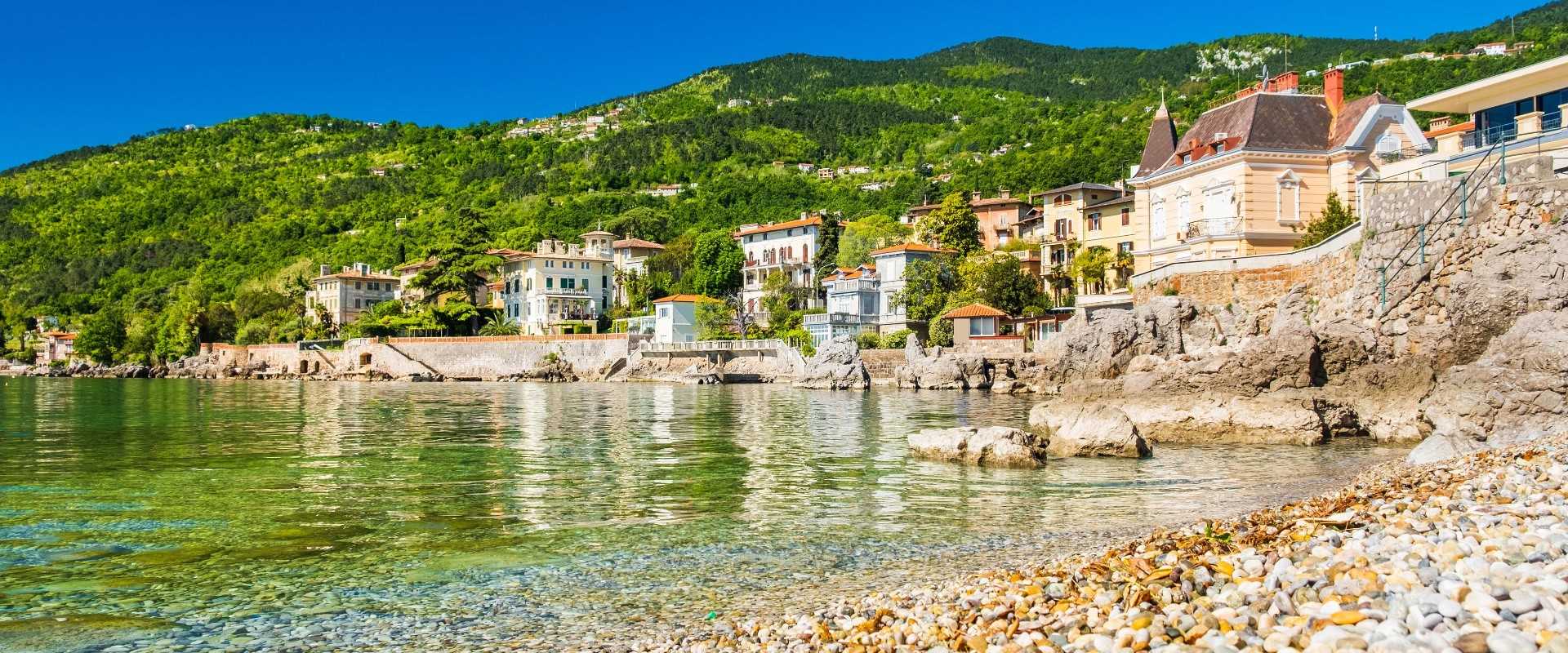Possibly because it has the best examples of elegant Secessionist villas by the sea (built during the Habsburg era) with grand gardens leading to the sea (best place to see them is by walking along the lungomare promenade). Or it could be because it is home to a famous, specialist orthopaedic hospital which was once Lovran’s five-star Grand Hotel. An exquisite building and people come here from all over Europe for orthopaedic surgery.
Located just five kilometres from larger Opatija, with a regular bus service (15 minutes) or walk there along the lungomare in around 75 minutes. The same bus continues to Rijeka, Croatia’s third city, journey time 30 minutes.
The longest lungomare (pedestrian seaside promenade) in Croatia is here. It is 12 kilometres long. It starts in the pretty former fishing village of Volosko to the east of Opatija and continues through Opatija, through Icici and Ika, finishing in Lovran to the west of Opatija (or start and finish the other way round, depending on how you look at it). The official name is Franz Josef I Promenade but in Croatia everyone uses the Italian term “lungomare” .
Dating back to the heyday of Opatija as a health resort for European aristocracy (especially Austrians) at the turn of the 19th and 20th centuries, it was built in parts: the part from Volosko to Opatija was completed in 1889 and the part from Opatija to Lovran was completed in 1911.
Locals are justifiably proud of it and stroll there all year. The views of the entire Kvarner Bay and her islands are stunning. In addition to the gorgeous historic villas, lungomare is something of a nature lesson too. Aromatic rock samphire on the rocks, evergreen holm oaks, pine trees and fragrant laurel (from where Lovran took its name). At various spots there are monuments such as the “Maiden and the Seagull” in Opatija”. The whole walk from Lovran to Volosko is around two hours at a decent pace or more if stopping on one of the beaches or the café-bars on the way.
Lovran was ruled by the counts of the neighbouring Istria region until the 15th century, when Austrians took over and it remained under Austrian rule until the Habsburg empire fell apart at the end of World War I. Modern tourism arrived in the late 1800’s as steamships arrived from Italy and the luxury villas went up by the sea. Today there is a mix of hotels (only four), villa and apartment accommodation often in heritage properties (as are the Villa Lovran Apartments we feature).
Today, visitors will enjoy the old town of Lovran perched above the harbour. Forget cars, many streets are like alleyways. Charming. There are names for the grand city “gates” (really archways) and this indicates the importance once of this stunning town (which was previously called a city). Inside the gates there is an enchanting clutter of courtyards, narrow streets, squares around St George’s Square and church of the same name which was built in the 12th century. There’s a charming old heritage theatre building restored to a small cinema, called “Freedom Cinema” (in Croatian) with films in original language so many are in English.
Good choice of restaurants from simple bistros to beachfront restaurants, fast food and a Michelin star restaurant “Draga di Lovrana” on the hill above Lovran (fabulous views across Kvarner Bay), 10 minutes by taxi. Bars and cafes in the old town and on the lungomare overlook the sea.
Some interesting shops including jewellery, beachwear, speciality local foods and wine.
There are a number of pebble coves and rocky beaches accessed by steps from the lungomare. The two largest ones are Peharovo Beach, a lovely pebbled cove with a beach bar, changing facilities and showers, toilet, (opposite the bus terminus stop) and Lovran Beach a longer curved stretch of terraced stone beach with sunbeds and parasols for hire. A beachfront simple restaurant-café and bar terrace, ice cream cabin, showers, toilet and occasional morning Yoga and live music some evenings in July and August.
Lovran is an excellent choice for an authentic Kvarner experience, close to islands, Opatija and Rijeka and the green hinterland hills.
Did you know?
- That Lovran was named after the laurel tree (bay leaves to us) and the scent of bay is around in summer months
- Mont Ucka Nature Park stretches inland from Lovran, highest peak 1,401 metres at Mount Vojak, topped by an old tower for panoramic views over Kvarner Bay. Drive up with car. 50 hiking paths and 8 mountain-bike trails there
- A boat excursion to two of the Kvarner Bay islands leaves daily from Lovran including the islands of Krk and Cres, stops on both islands for swimming, the beach, drinks then lunch on board and complimentary wine, and soft drinks. Bookable at kiosks on the seafront road. Whole day cost approx. £35 per person.
- Lovran is famous for a special type of chestnut called “marron”. There is a festival to them in October with music and dancing and restaurants and cafes have “marron” specialities.





